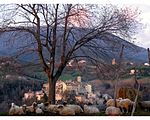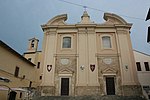Cantalupo in Sabina
Cities and towns in LazioLazio geography stubsMunicipalities of the Province of Rieti

Cantalupo in Sabina (Sabino: Candalupu) is a town and comune in the province of Rieti, on the Sabine Hills of Lazio. It is famous as the reputed origin of the melon called a cantaloupe melon. It is one of several Italian comuni named "Cantalupo" ("song of the wolf" or "howl of the wolf" or literally "sings wolf") and it seems that these place names are due to an elevated presence of wolves at the time of their naming (probably because wolves could be heard howling, but this etymology is actually disputed nowadays).
Excerpt from the Wikipedia article Cantalupo in Sabina (License: CC BY-SA 3.0, Authors, Images).Cantalupo in Sabina
Strada Regionale 313 di Passo Corese,
Geographical coordinates (GPS) Address Nearby Places Show on map
Geographical coordinates (GPS)
| Latitude | Longitude |
|---|---|
| N 42.3 ° | E 12.65 ° |
Address
Strada Regionale 313 di Passo Corese
Strada Regionale 313 di Passo Corese
02047
Lazio, Italy
Open on Google Maps






